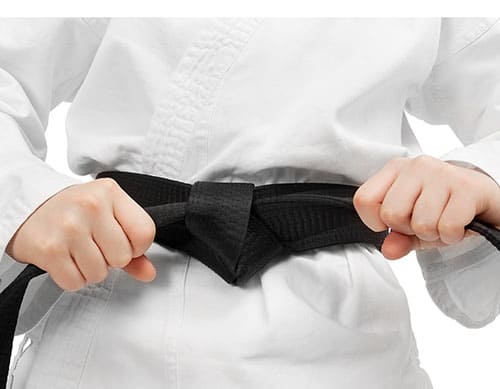
When looking to tie your TaeKwonDo belt, you will have a couple of options to choose from and a few decisions to make. Where do you start? How do you know you’re tying the belt correctly? How do you learn how to do it?
The 2 ways to tie a TaeKwonDo Belt are the Single Wrap and the Double Wrap. Their is also a technique for tying a belt for your child.
Although one option may be better then the other, here is a guide to how you can tie a TaeKwondDo Belt using either method and how you can know help your child tie his or her belt the correct way!
Your Best Options
Either before you get to your Taekwondo school or just before class starts, when you first start taking TaeKwonDo you tie your belt in what can only be described as a big knot ( at least that was my experience)
Then when you get to the class, the instructor will come over and re tie the belt, or if you are older, he will show how it should be done.
The way that normally is shown is usually done by beginners, where you start with the halfway point at your naval and then wrapped around twice where its then tied in the front leaving a untidy crossover in the back.
This is usually sufficient and gets you through class for that day and then from there on in you just used to doing it this way and before long it becomes a habit.
The thing is that its really not a major issue on a day to day basis as, at least in the classes that I took, as only on a small number of occasion does it ever become major focus of the class.
However at some point you are going to need to learn the proper way to tie a TaeKwonDo belt the proper way because at some point in your training an instructor from your school or maybe even another is going to call you out on it and wonder how is it possible that someone of such a high rank does not know how to properly tie there belt?
And to use the excuse that this was the way you were shown when you first started and is the only way you know is just not going to go over very well. (I know this because I have seen it). So lets go over the 2 ways to properly tie your Tae Kwon Do belt.
The Uncommon Single Wrap
In 1985 there was a TaeKwonDo meeting and at that meeting there was an agreement made that the belt should only be wrapped around once.
The reasoning was by wrapping it around just once it was to signify the pursuit of one goal, to serve one master with unparalleled loyalty and to get a victory against an opponent in one blow.
For a single wrap you will need a shorter belt then may be currently used in your school.
Step 1
Start with one side in your right hand and leaning down slightly and bring the rest of the belt around your waist. Alternatively you can split the belt in half and start in the middle of you lower back and wrap around to the front forming an X.
Step 2
The left side that you wrapped around you goes underneath the belt that is against your stomach and back up to the top. Tie it slightly so the belt stays in place. If the belt is uneven at this point shift either left or right so that both ends of the belt are even when held out straight.
Step 3
Now you just need to tie the belt by taking the top end and tighten with both hands. If you tie with the bottom end, it will come out looking off with one end going perpendicular and it will not only look unkept but the higher end will get in your way while training. If you wrap correctly, the belt will look like one belt.
The Common Double Wrap
In most of the cases that I have seen this is the more common method used due to the length of the belt given too the student by his teacher.
Step 1
Fold the belt in half and then half again. Take the first fold in your right hand, so one-quarter of the belt hangs on the left side, three-quarters hang down on the right. Put the fold against your front.
Step 2
Fold the belt in half and then half again. Take the first fold in your right hand, so one-quarter of the belt hangs on the left side, three-quarters hang down on the right. Put the fold against your front.
Step 3
In the front, one end will be on the top, one end will come out from underneath the layers of belt. Take the topside end and slide it under all the layers of belt. This is half of the knot.
Step 4
In the front, one end will be on the top, one end will come out from underneath the layers of belt. Take the topside end and slide it under all the layers of belt. This is half of the knot.
Step 5
Lay the top end across the loop and bring it up through the loop.
Step 6
Snap knot tight. It should have a square knot’s distinctive three loops – one on one side of the knot and two on the other.
The knot need not face a particular way. The ends should be of equal length. With a black belt, your stitched name should hang to your right.
How to Tie a TaeKwonDo Belt on A Child
Now that we hopefully have learned how to properly tie a TaeKwonDo belt for the teenager and adults , I thought I would take this one step further and show you have to tie the belt for your child.
Its slightly less complicated and less strict in regards to how it shows in the back and an easy way to show your child how to tie a belt so they can start doing it on their own.
Step 1
Start by kneeling down so that you are basically face to face with your Child(its easier this way then standing). Then fold the belt in half and take the middle and put it on or just below the belly button.
Step 2
Then take the belt and wrap both sides of the belt around your child crossing over at their back and bringing both ends to the front, depending on the length of the belt you may need to do this twice.
When both ends are in front they should be the same length. If they are not you will need to adjust accordingly.
Step 3
Pull the left side of the belt underneath both layers of the belt at your belly button and pull it out the top. Pull gently up on it at the same time you pull down on the other side.
Step 4
Now take the left side of the belt and pull it under and up the double wrapped part of the belt or against the uniform. This should done in the center i.e. near the belly button.
Once you have pulled it underneath and are now pulling on the top, you should pull the other end at the same time so that the belt is tightening around the waist (but not too much)
Step 5
Okay from here the top one goes over (creating a half circle) and the bottom one goes over the top and from there you are going to loop it through and then grab both ends of the belt and pull on it.
Here is a video which may visually explain it.
Belt Tying and Respect For Others
Historically speaking, its a courtesy and a sign of respect in TaeKwonDo to turn away from others whenever you are tying your belt. This is especially important to those of higher rank and of upmost importance to never tie your belt while facing your instructor.
The first TaeKwonDo school I was in, I saw a higher ranking student start to tie his belt in front of our instructor and when the instructor saw this, well lets just say tensions were high and there not too many kind words spoke.
The instructor even told the student to leave the school for that day. My instructor was very rigid in certain respects, but as I look back on it now I do understand his point of view at that time.
In the school I go to and the ones I have visited, I am seeing the less and less in those classes and the instructors not as adamant in having the student turn away but I think its a small gesture of respect to do this and I do it every time I need to tighten or redo my belt.
Belt Tightness
A lot of beginning students tend to over tighten their belts to the point where you wonder how are they even breathing? To determine the correct tightness of a belt you can use the thumb test where you put your thumbs inside the belt and make sure they can move about without any problems.


